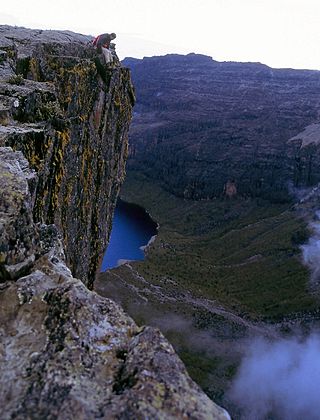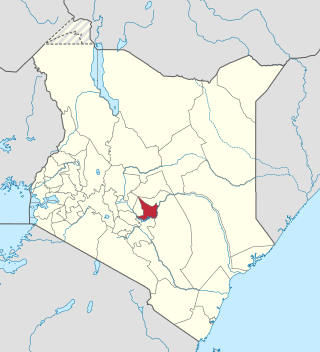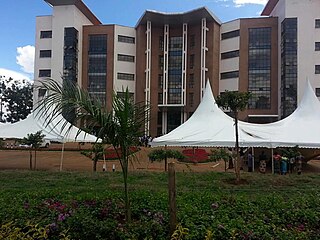Related Research Articles
Meru is a town in eastern Kenya. It is the headquarters of the Meru County, and the seventh largest urban centre in the country. Meru forms a municipal council with a population of 240,900 residents.

Meru County is one of the 47 counties of Kenya. It borders Isiolo County to the north, Tharaka-Nithi County to the east, Nyeri County to the southwest and Laikipia County to the west. The home of the Meru people, Meru County has a population of 1.55 million people.

The Meru or Amîîrú are a Bantu ethnic group that inhabit the Meru region of Kenya. The region is situated on the fertile lands of the north and eastern slopes of Mount Kenya in the former Eastern Province.
Meru is a Bantu language spoken by the Meru people (Ameru) who live on the Eastern and Northern slopes of Mount Kenya and on the Nyambene ranges. They settled in this area after centuries of migration from the north.

Maua is a town in Meru County, Kenya. From 1992 to 2009, it was the capital of the now defunct Meru North District.

Embu County is a county of Kenya. The capital of Embu County and the former Eastern province headquarters, Embu is a large and largely metropolitan area with a population of 608,599 persons. The county borders Kirinyaga to the west, Kitui to the east, Tharaka Nithi to the north, Machakos to the south. The county occupies an area of 2,821 km2.
Marakwet District is a defunct administrative district in the former Rift Valley Province of Kenya. Its capital town was Kapsowar. The district had a population of 140.629. Local people are predominantly of the Marakwet tribe.
Meru South District, also known as Nithi District, was an unconstitutionally created district of Kenya, located in that country's Eastern Province. In 1992, it was split from the large Meru District, along with Meru Central District, Meru North District, and Tharaka District. In September 2009, the Supreme Court ruled that its creation was unconstitutional, and that it belonged in Tharaka-Nithi District.

Tharaka-Nithi County is one of the 47 counties of Kenya. It was created from Kenya's erstwhile Eastern Province. The county has an area of 2609 km2 and as of the 2019 census a population of 393,177.

Mbeere District was a former administrative district in the Eastern Province of Kenya. Its capital town was Siakago. The district had a population of 170,950 and an area of 2,093 km2. The district was split from Embu District in 1996. In 2010, it was merged into Embu County.

The districts of Kenya were divided into 262 divisions (matarafa). Divisions of Kenya were further subdivided into locations. Today's counties of Kenya are based on the merging of some of the districts on this list and since the divisions are one level under the districts they are now the sub-counties. This is because Kenya recently changed its constitution and 47 Counties emerged. Here are the divisions listed below, by district :

Chuka is a town on the eastern slopes of Mount Kenya, in Kenya about 65 km south Of Meru Town. It falls within Tharaka-Nithi County and the former Eastern Province. Between 1992 and 2009, Chuka was the capital of Tharaka Nithi District. Tharaka Nithi District was further split into Meru South and Tharaka Districts with Chuka remaining the Capital of Meru South. Later, Meru South and Tharaka were amalgamated into Tharaka-Nithi County.

Peter Gatirau Munya is the immediate former Cabinet Secretary of Kenya's Ministry of Agriculture. He took over the ministry on 14 January 2020 after being transferred from the Ministry of Trade and Industrialization. He also served in the same capacity in the ministry of East African Community and Northern Corridor Development.
Field Marshal Musa Mwariama, EBS (1928–1989) was a Kenyan revolutionary leader of the Mau Mau in Meru and the highest-ranking Mau Mau leader who survived the war without being killed or captured. Together with Field Marshal Dedan Kimathi, they comprised the core Mau Mau leadership. Mwariama was the highest ranking leader among the Meru side of the uprising.
Tigania East Constituency is an electoral constituency in Kenya. It is one of nine constituencies of Meru County. The constituency has five wards, all of which elect councillors for the Nyambene County Council. The constituency was established for the 1997 elections.
Tigania West Constituency is an electoral constituency in Kenya. It is one of nine constituencies of Meru County. The constituency has five wards, all of which elect Members of County Assembly (MCAs) for the Meru County Assembly. The constituency was established for the 1997 elections.

Sub-counties are the decentralised units through which county governments of Kenya will provide functions and services. Except for the parts which fall under urban areas, sub-counties will coincide with the constituencies created under article 89 of the Constitution of Kenya. Sub-counties will be headed by a sub-county administrator, appointed by a County Public Service Board.
Ciokaraine M'Barungu, known simply as Ciokaraine, was a prominent female diviner, political leader and human rights activist from Igembe, Kenya. She was a fierce supporter of women's rights and is known for having offered up her son's life in order to prevent a famine during the Mau Mau Uprising.
Igembe Central is a constituency in Kenya. It is one of nine constituencies in Meru County.
References
- ↑ Nyasato, Robert (5 September 2009). "High Court outlaws 210 districts created by Moi and Kibaki since 1992". The Standard. Archived from the original on 1 July 2014.
- ↑ "unknown" (PDF). Archived from the original (PDF) on 2020-03-01. Retrieved 2007-03-03.
{{cite web}}: Cite uses generic title (help) - ↑ "Annex 1: Status of Coverage of Communications Services" (PDF). Communications Authority of Kenya. p. 6. Archived from the original (PDF) on September 28, 2007. and "Urban Poverty all Kenya Province through Location (Final)". International Livestock Research Institute (ILRI), Consultative Group on International Agricultural Research (CGIAR). Archived from the original on July 18, 2011.